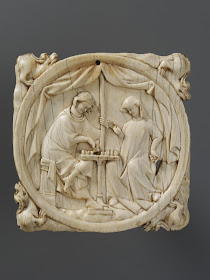Seasonal Greetings, and a question: have you seen this before?
 |
| Mirror Case with a Couple Playing Chess, 1325-1350. France, Paris, C14th. Ivory 10.20cm diam. The Cleveland Museum of Art |
If you think you have, think again...
...maybe you really saw this...
 |
| A Game of Chess (Mirror Case) France, Paris, ca 1300. Elephant Ivory. 10.5 x 10.4 cm Victoria and Albert Museum |
...with embellishments on the rim, and a more incisive cut over-all.
Note the other subtle differences that enhance the suggestiveness in the design - if that's how you want to see it, and surely that is what was intended (blatantly, some would say). In the V&A version on the right the lady now unveils herself, and rather than refer to a tactic on the board she raises her hand in (mock) alarm. She brushes her partner's wrist, "accidentally-on-purpose" as we used to say, and by this means the two players are artfully conjoined. That marsupial fold in her gown appears even more inviting. Come on in.
Courtly dalliance, amorous games, discreet couplings - all a bit steamy, and based on the ancient legend of Tristan and Isolde. It was a tale well told. Often. Here they are again. Twice.
 |
| Left: Mirror Case Paris c1300. Ivory. Diam 11.50cms. Louvre. Right: Mirror Cover with a Couple Playing Chess Origin Germany (?). Mid C14th. Ivory and Bone. 9.5 x 10 cms. Walter Museum. |
So, it is with a sense of relief, perhaps, that we get to the rather more chaste German version on the right, where the two young people seem to enjoy their chess as a non-contact sport - or maybe it's just that the chill of the sylvan glade has cooled their ardour which they will rekindle under canvas. But note that some familiar motifs (his upright, her crease) are still in play, if less obviously in your face.
Now: another format re-cycling the same theme.
 |
| Left: Leaf of a Writing Tablet French, Made in Paris. C14th. Ivory. 11.7 x 7.8cm. Met. Museum of Art. Right: Side of Casket Made in France. C14th. Ivory. Overall 8.1 x 18.3 x 10.5 Met. Museum of Art. |
Without attempting an intimate antiquarian analysis of all this (which you get anyway on the excellent Victoria and Albert page) observe the remarkable similarity of style, and the re-cycled motifs, suggesting a common source of manufacture. But, getting now to the point of this post, a friend of mine from way back when, and now living in Italy, has come across yet another variation on the theme - in Perugia. So, here we show it: to an unsuspecting chess audience for maybe for the first time.
 |
| Ivory mirror case. French. First half C14th. Galleria Nazionale dell'Umbria. |
Acknowledgments.
With thanks to Peter Mason for the tip and the last pic.
Lost in Art

No comments:
Post a Comment
Please do not post anonymously if you have anything controversial to say. Abusive, offensive and legally iffy comments will likely be deleted.